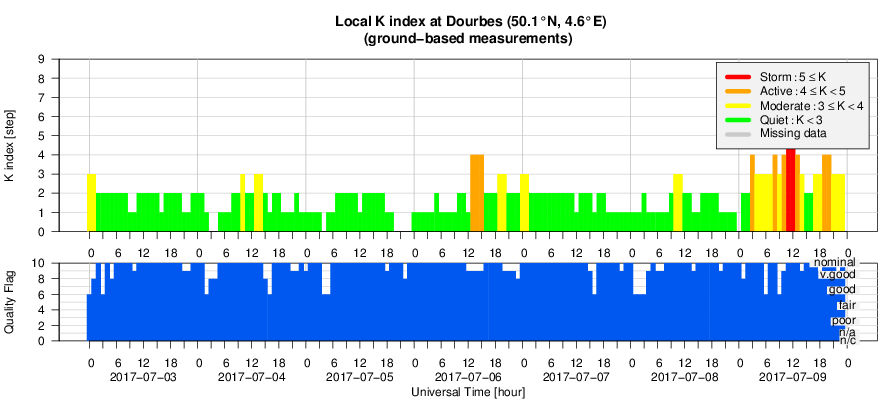- Table of Content
- 1.A Sunday morni...
- 2.PROBA2: Eighth...
- 3.Review of sola...
- 4.Noticeable Sol...
- 5.PROBA2 Observa...
- 6.The Internatio...
- 7.Review of geom...
- 8.Geomagnetic Ob...
- 9.SIDC Space Wea...
- 10.Review of iono...
- 11.Future Events
2. PROBA2: Eighth Call for Guest Investigators
3. Review of solar activity
4. Noticeable Solar Events (3 Jul 2017 - 9 Jul 2017)
5. PROBA2 Observations (3 Jul 2017 - 9 Jul 2017)
6. The International Sunspot Number
7. Review of geomagnetic activity
8. Geomagnetic Observations at Dourbes (3 Jul 2017 - 9 Jul 2017)
9. SIDC Space Weather Briefing
10. Review of ionospheric activity (3 Jul 2017 - 9 Jul 2017)
11. Future Events
A Sunday morning solar observing session
What does a solar observer do on a quiet and sunny Sunday morning? Observing the Sun of course, in particular if one of the largest sunspot groups of the year (so far) is transiting the solar disk. According to the NOAA data (http://www.swpc.noaa.gov/products/solar-region-summary ), active region NOAA 2665 had a surface area of more than 4 times that of the Earth, and it was long enough (front-to-end) to fit 10 Earth's next to each other! The sunspot region was relatively compact, and was reported a naked eye object (using solar eclipse glasses of course: keep it safe!). The Mount Wilson Observatory (http://obs.astro.ucla.edu/images/cur_drw.jpg ) measured the magnetic field strength in the main spot to be more than 3500 times the intensity of the Earth's magnetic field. The region had produced several C-class flares during the early hours of 9 July, as well as 1 M-class ("medium") flare that peaked at 03:18UT.
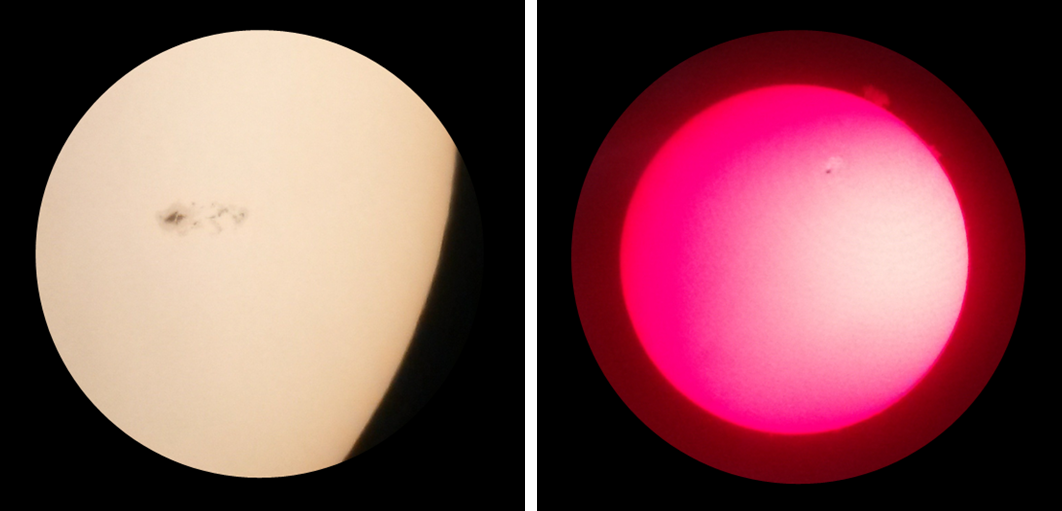
The image above to the left shows NOAA 2665 in white light at 06:46UT and was taken by the author through a modest sized telescope and a handheld smartphone, which explains the somewhat blurred appearance of the group. The eastern solar limb is on the right. The complexity of the region and the large size of its main spot are obvious, with a light bridge splitting the umbra (dark "core") of the main spot. Pending the size of the telescope and the timing of observation, observers counted between 15 and 30 sunspots in the region. The image to the right shows a full disk solar image in H-alpha, a spectral line in the red part of the solar spectrum revealing the Sun's lower atmosphere at a temperatures of about 10.000 degrees. The dark spot in the upper right quadrant is the main spot of NOAA 2665, with the brighter trailing region indicative of where a modest C-class flare had occurred just a few minutes earlier. H-alpha is indeed often used by ground-based observatories to catch a solar flare. The red expulsions at the upper right solar limb are modest-sized prominences, areas of charged particles squeezed between magnetic fields of opposite polarity.
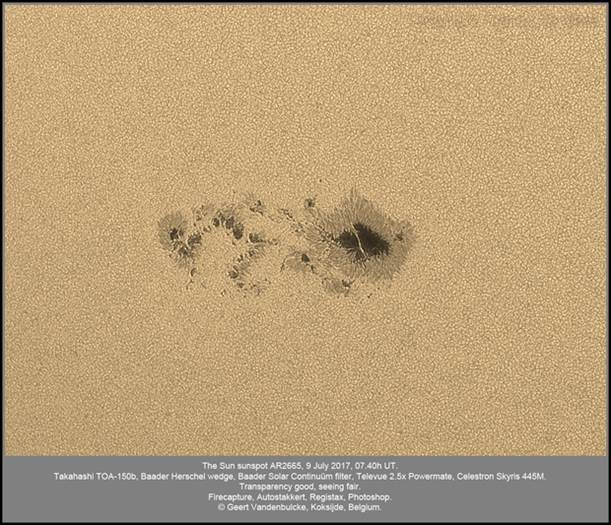
Some solar observers have accumulated many years of experience in astrophotography and image processing, and have a professional telescopic set-up and camera's. As such, they are able to make jaw-dropping, high-resolution, picture-perfect solar images. Geert Vandenbulcke (http://www.astrobin.com/users/Tranquility-Base/ ) is such a Belgian "amateur" solar observer of international fame. Taken at about the same time (between 07:00 and 08:00UT on 9 July), the image above shows NOAA 2665 in white light, and a full disk Sun in H-alpha can be seen in the image below. The amount of detail is already astonishing in these images, but visiting Geert's website and taking a look at the full-sized images makes one really appreciate the visible details in the active region and in the Sun's atmosphere in all their grandeur!
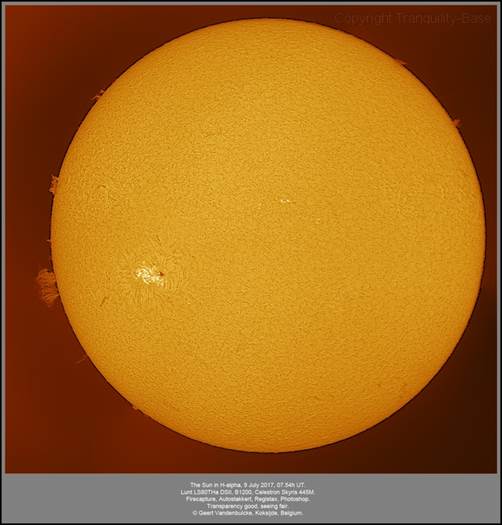
PROBA2: Eighth Call for Guest Investigators
The PROBA2 team welcomes research proposals for the eighth round of its Guest Investigator program for research based on SWAP and LYRA data analysis by scientists outside the SWAP and LYRA PI-teams. We encourage in particular young post-docs and PhD students to apply, although more senior guest investigators’ proposals are welcome also. In this round we anticipate funding for around five guest investigators or teams who will visit the PROBA2 Science Center at the Royal Observatory of Belgium, in Brussels, between September 2017 and May 2018.
Selected proposers will be invited to spend a few weeks with the PI teams to obtain expert knowledge on the instruments, to participate in the daily commanding of the SWAP and LYRA instruments according to the needs of their data analysis proposal, and to conduct their research.
Guest investigators may be reimbursed for travel, accommodation and living expenses up to a maximum of 5000 euro. Limited support to present the results at an international conference (during the visit at P2SC) can also be considered.
During the selection process, special consideration will be given to young scientists and PhD students, collaborative research teams with members from more than one research institute (funding above the 5000 euro level may be approved for such teams), and to proposals addressing research topics to which SWAP and LYRA are particularly well-suited.
More details about the application process can be found here:
http://proba2.oma.be/EighthGICall, or by emailing swap_lyra@oma.be
Deadline: Proposals must be received by 2017-Sep-24 (23:59 CET)
The PROBA2 team
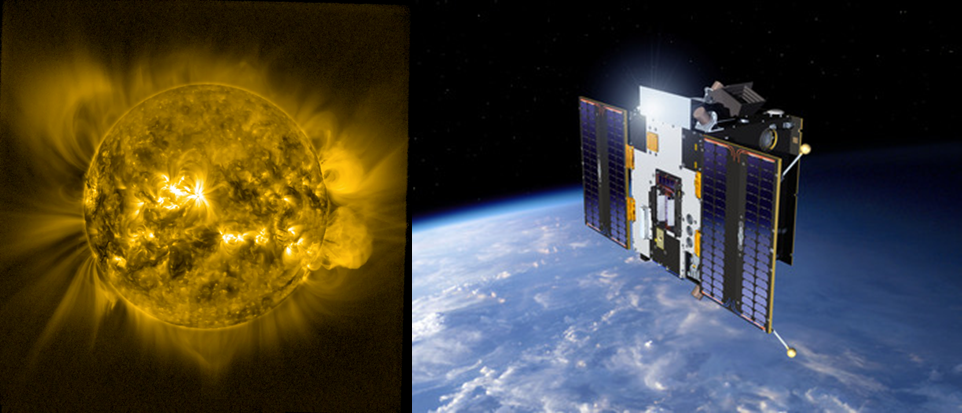
Review of solar activity
The week started with active region NOAA 2664 rotating over the west limb. Shortly after, a small unnumbered active region about 15 degrees south of NOAA 2664 produced an M1.3 flare on July 3 peaking at 16:15 UT. See SDO/AIA303 image underneath, and http://www.stce.be/news/390/welcome.html for more info on this event.
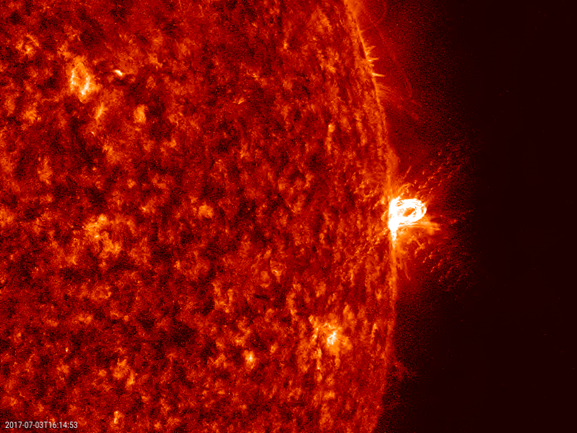
Active region NOAA 2665 rotated into view on July 6. It grew quickly in size, number of sunspots and complexity (with beta-gamma magnetic field configuration). The region produced numerous C-class flares and one M1.3 flare peaking at 03:18 UT on July 9. See the other topics in this Newsletter for more information.
No Earth directed Coronal Mass Ejections (CMEs) were observed. Solar energetic protons remained at background levels over the week.
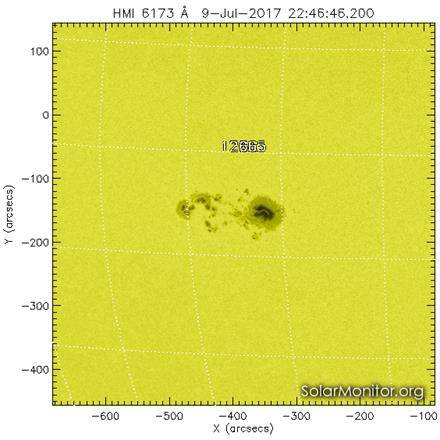
Noticeable Solar Events (3 Jul 2017 - 9 Jul 2017)
| DAY | BEGIN | MAX | END | LOC | XRAY | OP | 10CM | TYPE | Cat | NOAA |
| 03 | 1537 | 1615 | 1618 | M1.3 | III/1 | |||||
| 09 | 0309 | 0318 | 0337 | S8E37 | M1.3 | 2N | 36 | 2665 |
| LOC: approximate heliographic location | TYPE: radio burst type |
| XRAY: X-ray flare class | Cat: Catania sunspot group number |
| OP: optical flare class | NOAA: NOAA active region number |
| 10CM: peak 10 cm radio flux |
PROBA2 Observations (3 Jul 2017 - 9 Jul 2017)
Solar Activity
Solar flare activity fluctuated between very low and moderate during the week.
In order to view the activity of this week in more detail, we suggest to go to the following website from which all the daily (normal and difference) movies can be accessed: http://proba2.oma.be/ssa
This page also lists the recorded flaring events.
A weekly overview movie can be found here (SWAP week 380):
http://proba2.oma.be/swap/data/mpg/movies/weekly_movies/weekly_movie_2017_07_03.mp4
Details about some of this week's events, can be found further below.
If any of the linked movies are unavailable they can be found in the P2SC movie repository here:
http://proba2.oma.be/swap/data/mpg/movies/
Monday Jul 03
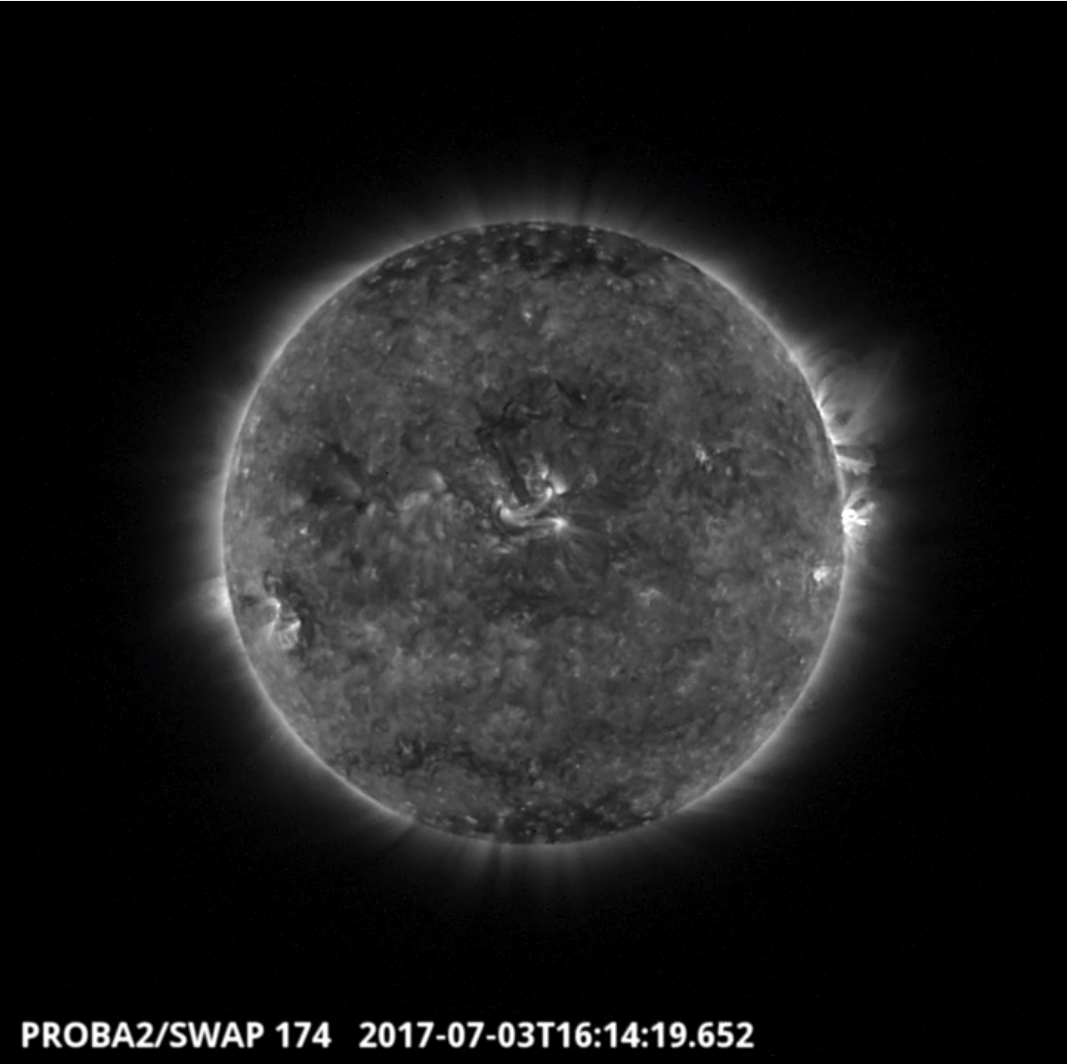
The first M-class flare of the week (M1.3) occurred on 2017-Jul-03. The flare and corresponding eruption can be seen on the western limb of the Sun at 16:14 UT in the SWAP image above.
Find a movie of the event here (SWAP movie):
http://proba2.oma.be/swap/data/mpg/movies/20170703_swap_movie.mp4
Sunday Jul 09
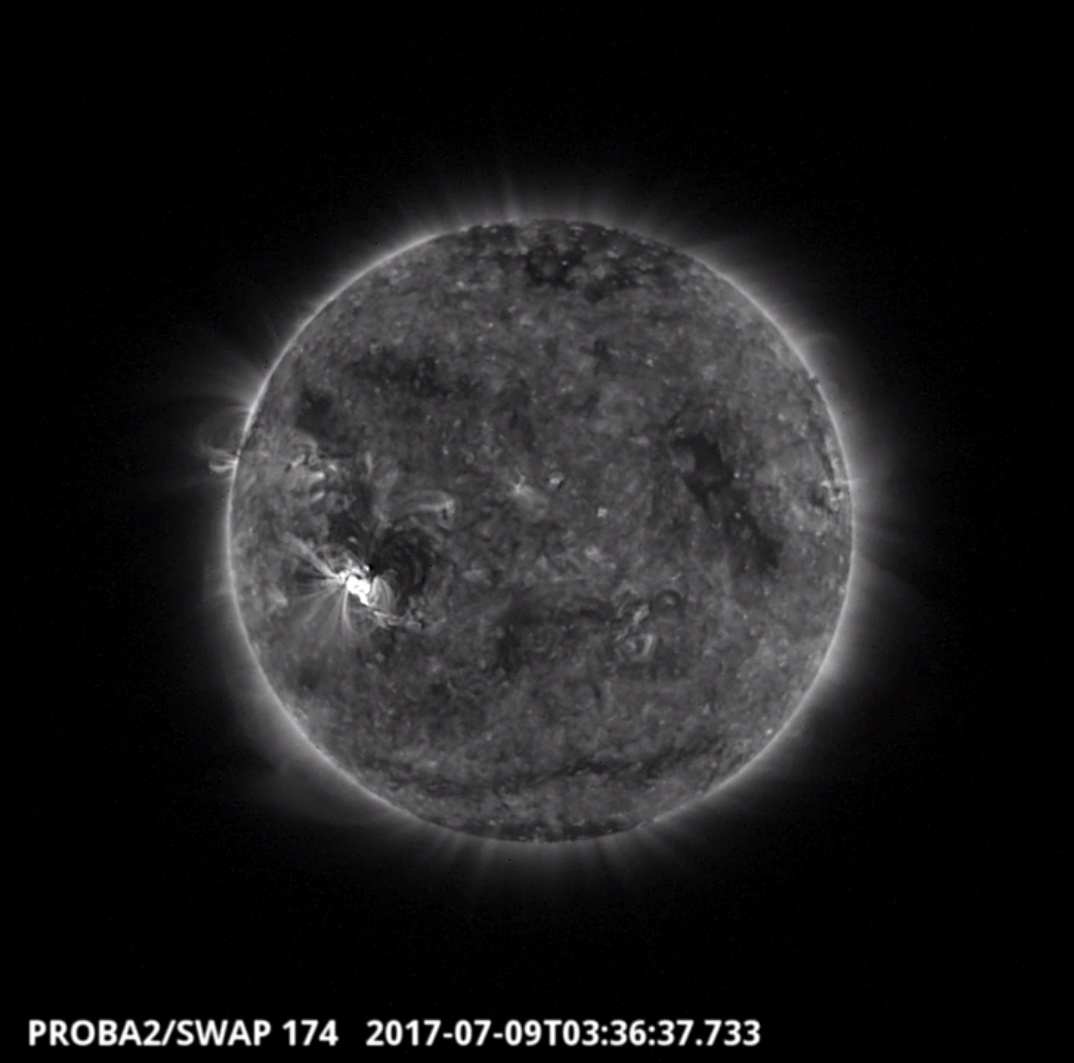
The second M-class flare of the week, also classified as an M1.3, was from NOAA active region 2665 and occurred on 2017-Jul-09 in the south-eastern quadrant of the Sun, as shown in the SWAP image above at 03:36 UT.
Find a movie of the event here (SWAP movie):
http://proba2.oma.be/swap/data/mpg/movies/20170709_swap_movie.mp4
The International Sunspot Number
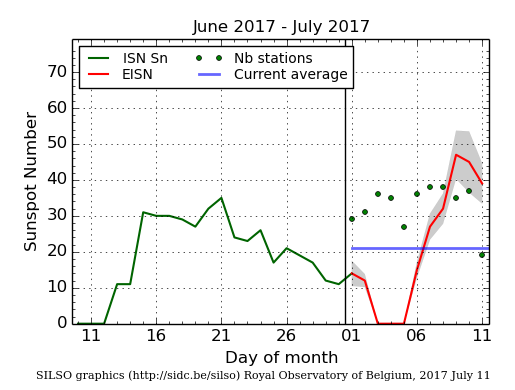
The daily Estimated International Sunspot Number (EISN, red curve with shaded error) derived by a simplified method from real-time data from the worldwide SILSO network. It extends the official Sunspot Number from the full processing of the preceding month (green line). The plot shows the last 30 days (about one solar rotation). The horizontal blue line shows the current monthly average, while the green dots give the number of stations included in the calculation of the EISN for each day.
Review of geomagnetic activity
Geomagnetic conditions were quiet to unsettled until July 8 when the fast solar wind from a positive polarity equatorial coronal hole arrived at the Earth. It drove a shock that reached Earth at 23:27 UT on July 8, the speed reached 600 km/s on July 9 with the southward component of the interplanetary magnetic fields reaching -10 nT, with elevated density. Minor storm conditions were recorded both locally (K Dourbes = 5) and at planetary levels (Kp = 5) during July 9.
See the SIDC Space Weather Briefing for images and graphs.
SIDC Space Weather Briefing
The Space Weather Briefing presented by the forecaster on duty from 3 July till 9 July. It reflects in images and graphs what is written in the Solar and Geomagnetic Activity reports. A.wmv version can be found at http://stce.be/movies/SIDCbriefing-20170709.wmv

Review of ionospheric activity (3 Jul 2017 - 9 Jul 2017)
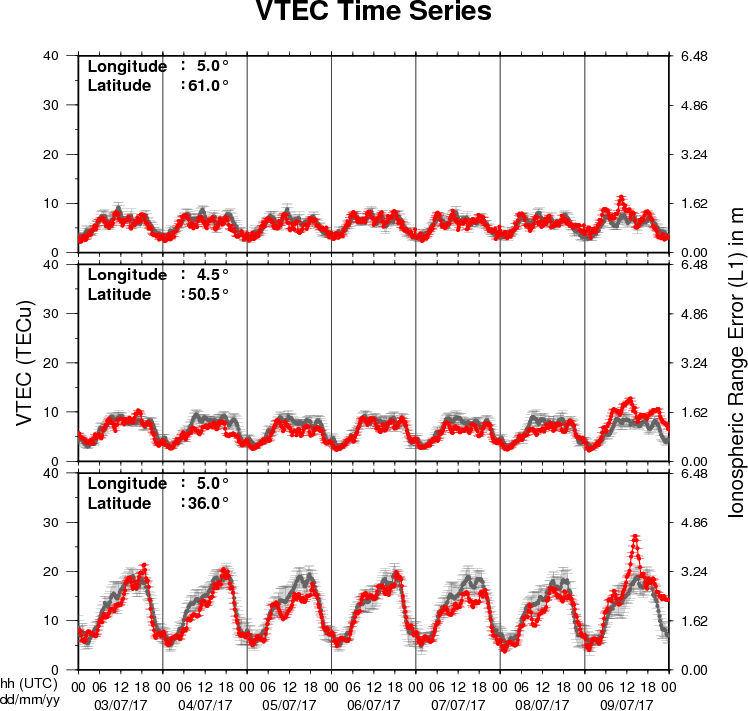
The figure shows the time evolution of the Vertical Total Electron Content (VTEC) (in red) during the last week at three locations:
a) in the northern part of Europe(N61°, 5°E)
b) above Brussels(N50.5°, 4.5°E)
c) in the southern part of Europe(N36°, 5°E)
This figure also shows (in grey) the normal ionospheric behaviour expected based on the median VTEC from the 15 previous days.
The VTEC is expressed in TECu (with TECu=10^16 electrons per square meter) and is directly related to the signal propagation delay due to the ionosphere (in figure: delay on GPS L1 frequency).
The Sun's radiation ionizes the Earth's upper atmosphere, the ionosphere, located from about 60km to 1000km above the Earth's surface.The ionization process in the ionosphere produces ions and free electrons. These electrons perturb the propagation of the GNSS (Global Navigation Satellite System) signals by inducing a so-called ionospheric delay.
See http://stce.be/newsletter/GNSS_final.pdf for some more explanations ; for detailed information, see http://gnss.be/ionosphere_tutorial.php
Future Events
For more details, see http://www.spaceweather.eu/en/event/future
United Nations/United States of America Workshop on the International Space Weather Initiative in Massachusetts (USA)
Start : 2017-07-31 - End : 2017-08-04
This workshop marks the 10th anniversary of the International
Heliophysical Year, which led to the genesis of the International
Space Weather Initiative. It is organized jointly by the Office for
Outer Space Affairs, the National Aeronautics and Space
Administration (NASA) and Boston College to highlight the
achievements made over the past ten years and to show-case the
worldwide development of science, capacity building, and
outreach.
The UN Workshops on ISWI have been aimed at providing a global
forum for space weather experts from developed and developing
countries, including representatives of the major instrument
operators and data providers. In particular the Workshop will focus
on recent advances made in scientific research by utilizing ISWI
instrument data in conjunction with space mission data in adding
significant new knowledge on space weather phenomena near Earth and
interplanetary space.
The workshop will begin with a high level international forum on
the economic and societal effects of extreme space weather. This
forum will include keynote speakers from major international
organizations followed by a panel session to discuss issues and
policies for acknowledging space weather as a global challenge.
The workshop is also held in preparation for UNISPACE+50 in
2018, the 50th anniversary of the first UN Conference on the
Exploration and Peaceful Uses of Outer Space (UNISPACE), held in
Vienna in 1968. The three components of the Workshop will also help
develop a coherent international policy towards an appropriate
response to space weather.
Website: https://iswi2017.bc.edu/
URSI General Assembly in Montreal, Canada
Start : 2017-08-19 - End : 2017-08-26
For the thirty-second time since the inception of URSI, Radio
Scientists from across the world will get together for the URSI
General Assembly and Scientific Symposium. This triennial gathering
will take place from 19th to 26th of August 2017, in Montreal,
Canada. This conference is a unique opportunity to learn about
recent advances in all fields of Radio Science, as covered by all
ten URSI Commissions.
Among the different sessions, please note:
* 'Radio Science for Space Weather'
Conveners: M. Messerotti, V. Pierrard
* 'Remote Sensing and Modeling of the Earth's Plasmasphere
and Plasmapause'
Conveners: A. M. Jorgensen, V. Pierrard, B. Heilig
The abstract deadline is 30 January 2017
Website: http://www.ursi2017.org
2017 Joint IAPSO-IAMAS-IAGA Assembly in Cape Town, South Africa
Start : 2017-08-27 - End : 2017-09-01
The Joint IAPSO-IAMAS-IAGA Assembly, endorsed by the University
of Cape Town and the South African Department of Science and
Technology, will take place from 27 August to 1 September 2017 at
the Cape Town International Convention Centre (CTICC). Several IAGA
and IAMAS sessions are of Space Weather interests as well as the
joint session 'Space Weather throughout the Solar System: Bringing
Data and Models together'.
Website:
http://iapso-iamas-iaga2017.com/index.php
Workshops on Radiation Monitoring for the International Space Station in Torino, Italy
Start : 2017-09-05 - End : 2017-09-07
The Workshop on Radiation Monitoring for the International Space
Station is an annual meeting to discuss the scientific definition
of an adequate radiation monitoring package and its use by the
scientific community on the ISS. Types of instruments and research
topics need to be defined in order to optimise the radiation safety
of the ISS crew.
Website: http://wrmiss.org/
International Workshop on Solar, Heliospheric & Magnetospheric Radioastronomy in Meudon, France
Start : 2017-11-06 - End : 2017-11-10
Jean-Louis Steinbeg has been one of the major pioneers in
radioastronomy. Co-founder of the Nançay Observatory, he
has actively participated to, an inspired a large number of radio
instruments on many international space missions. Jean-Louis
Steinberg is the founder of the Space Radioastronomy laboratory of
the Paris Observatory in 1963. Later on, this laboratory widened
its science interests and became the DESPA (1971) and then the
current LESIA (2002) which is one of the major space sciences
laboratories in France. The aim of this workshop is to cover the
science topics which Jean-Louis Steinberg has promoted during his
career, focusing on Solar, Heliospheric & Magnetospheric
radioastronomy & physics. This will be done by covering both
observations from either ground facilities (NDA, RH, LOFAR, Artemis
etc ...) or space missions (ISSEE, Ulysses, WIND, CLUSTER, STEREO,
CASSINI, JUNO etc ...) and models/theories. A series of invited
talks is also foreseen to cover the new developments in the
discipline which may come with the future facilities such as Solar
Orbiter, Solar Probe Plus, JUICE, JUNO, LOFAR+, SKA etc ....
This workshop will also be the opportunity to remember both the
extraordinary personal & professional lifes of Jean-Louis
Steinberg especially for new generation of scientists. At the
occasion of this workshop it is also expected that the Building 16
(historical Space Sciences building) on the Meudon campus will be
renamed "Building Jean-Louis Steinberg".
Website:
https://jlsworkshop.sciencesconf.org/
European Space Weather Week 14
Start : 2017-11-27 - End : 2017-12-01
The ESWW is the main annual event in the European Space Weather
calendar. It is the European forum for Space Weather as proven by
the high attendance to the past editions. The agenda will be
composed of plenary/parallel sessions, working meetings and
dedicated events for service end-users. The ESWW will again adopt
the central aim of bringing together the diverse groups in Europe
working on different aspects of Space Weather.
Website:
http://www.stce.be/esww14/
